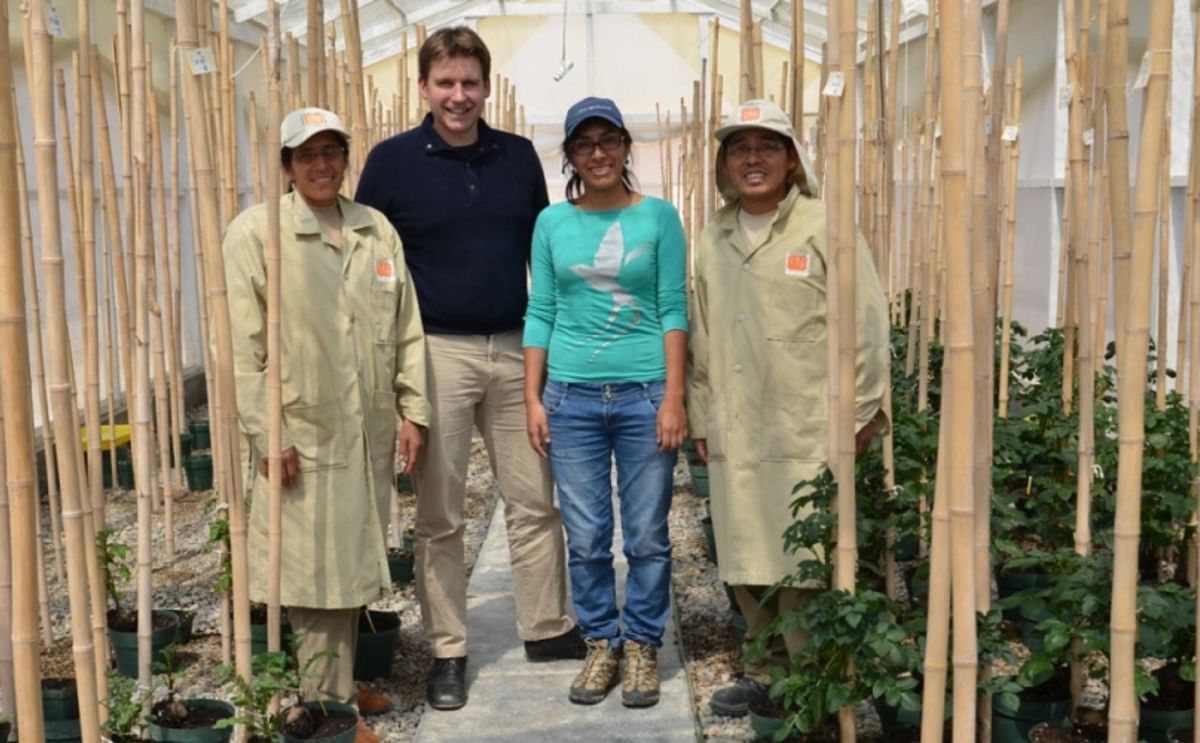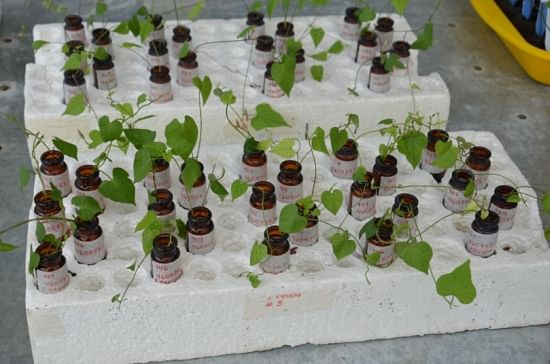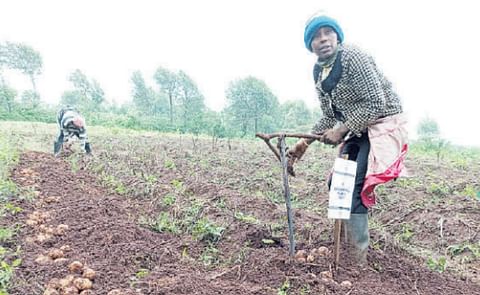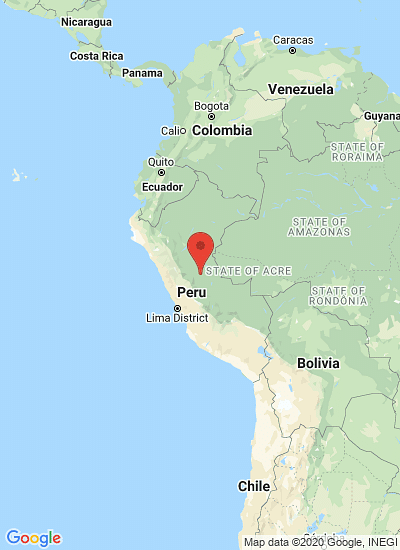Crop Trust CWR project manager, Hannes Dempewolf, second from left,with CIP staff at a CWR in situ site. (Courtesy: Bettina Heider, CIP)
Crop Wild Relatives May Hold Key to Counteract Effects of Climate Change in Agriculture

They grow in some of the world’s most inhospitable conditions. Unlike their pampered domesticated relatives in order to survive they’ve needed to adapt on their own to high temperatures, high saline conditions, drought, and disease. Scientists now believe that these wild plant species related to domesticated crops, known as Crop Wild Relatives (CWR), might just hold a key to counteract the devastating effects of climate change on the world’s food supply.
As the earth’s temperatures rise harvests are expected to fall short. Models show possible yield losses of 6-10% for every 1° C increase in temperature. Crop diversity is more important than ever and yet in the U.S. alone 90% of the fruit and vegetable varieties were lost in the past century. Investing now in preserving and mining the resilient traits of CWR can help safeguard the world’s food supply.
This is exactly what a decade-long, global initiative is doing: “Adapting agriculture to climate change: collecting, protecting, and preparing wild relatives.”
Now in its fifth year, after a worldwide Gap Analysis study that has given us a detailed, exhaustive report on the state-of-the-world in regards to CWRs, we know what we have and what we need to collect and conserve in global system for ex situ conservation. Most importantly, once safeguarded, the adaptive traits of CWRs need to be mined and used to help the world’s staple foods adapt to the challenges posed by climate change.
Currently pre-breeding efforts have started on the CWRs of 26 key crops of major importance to food security, two of them in Peru, home to the world’s largest range of potato CWRs. In the Andean highlands of Huancayo and the Amazonian mountains of San Ramón the International Potato Center (known as CIP for its acronym in Spanish) has been working hard to preserve, clean, pre-breed and make potato and sweetpotato CWR varieties available for use.
Potatoes and sweetpotatoes are critical crops to food security particularly among the world’s poor. More than a billion people worldwide eat potatoes making it the third most important staple food crop after rice and wheat; while a full 95% of the 105 million metric tons of sweetpotatoes produced each year are grown in developing countries.
This long-term view at preserving crop diversity is a $50 million dollar effort funded by the Norwegian government through the Global Crop Diversity Trust, an independent body looking to ensure the conservation and availability of crop diversity for food security worldwide, with the Millennium Seed Bank. In the coming years the Project will deploy pre-bred materials with traits of importance to climate change already existing in the CIP and the National Institute of Agricultural Research of Uruguay (INIA)’s Potato Breeding Programs into elite new lines that account for such stressors as: drought, heat tolerance and disease resistance, while accounting for enhanced yields and user preference traits.
Wild Relatives Take Time to Tame
The challenges we are facing now, and those that we will face in the future, demand our plant breeders develop crops that can adapt to unforeseen and as yet unknown conditions. CWR hold traits that no domesticated variety has developed. Working with untested and unpredictable wild relatives, however, takes time.
Luis Salazar. Crop Trust communications manager:
“What you are doing is basically crossing a housecat with a tiger.”This is not an overnight process. It can take decades before a pre-breed is ready to be used by breeders, and even longer before materials are in the hands of the farmers who need them.
“You might get an animal with fangs and large claws but you wanted the strength and size of the tiger and not the claws and fangs. You have to go through the (time-consuming) experiments to get what is needed by the breeders.”
One of the Project’s objectives is to develop and promote pre-breeding material that may readily be used by interested parties. A treaty signed by 136 countries, including Peru, enables parties to share genetic plant material freely. As a result CIP was able to access germplasm from Brazil that might have otherwise taken years to negotiate. CIP scientists are tapping the broad base of the genetic populations available to develop new adapted varieties.
Crop Trust scientist and CWR project manager, Hannes Dempewolf, recently visited the CIP pre-breeding sites. “One of the most exciting things about the (CIP) sweetpotato project is that wild relatives have never been used in pre-breeding for any purposes,” says Dempewolf. “This is the very first time we are doing anything with wild relatives for sweetpotatoes. It is very experimental, because it is the first time the outcome is much riskier, but it is also very important to sweetpotatoes in the future.”

A multiplication of plantlets used in crossing experiment with a variety of sweetpotato CWR. (Courtesy: Bettina Heider, CIP)
Banking on the Future
In-situ and ex-situ conservation methods are at the heart of the CWR project. CIP stores samples in its gene bank and as an added insurance measure sends a back up to the Svalbard Global Seed Vault in Norway with funding from the Crop Trust. Since CWR face the same challenges as their domestic relatives: rising temperatures, drought, and floods to name of few, it becomes essential to allow CWRs to continue to evolve to resist new stresses.
Flor Rodriguez, CIP associate scientist:
“With in situ conservation the material adapts to changes, and perhaps some of those variants will adapt to new climates and new conditions.”As scientists develop new pre-breeding germplasm equipped to take on harsh climatic conditions it is also made available for broader use. The Crop Trust facilitates this process further by standardizing the information captured by different parties and housing it in a central portal on plant genetic resources called Genesys.
“These changes help us to identify the adaptations. It creates a reservoir of new varieties that we can use. While the ex situ helps us to preserve genetic diversity in a specific period of time. This protects the material from changes like hail, earthquakes and road construction. Both types of conservation compliment each other.”
The Right Information Facilitates Research
The problem in the past is that each research institute had its own standards making it difficult to share information. While one organization might have classified a potato species as moderately tolerant to drought another might have deemed the same species as moderately susceptible. Scientists could not easily use the findings from another research institute because there was no consensus in how the data was being captured and interpreted.
Elisa Mihovilovich, CIP associate scientist:
“By creating protocols we can now exchange data, we know if someone else has looked at 5 particular species they’ve been documented with the same protocols (we use): altitude and latitude, time of year, environmental information, and other variables.”As the hidden potential of CWRs is unlocked that information becomes an influential tool. “We are trying to get a mind change in breeding communities to think of wild relatives as an important source of genetic material to adapt crops to changing climatic conditions,” says Dempewolf. A widening genetic database derived from the hidden treasures to be found in CWRs means crops better suited to the earth’s changing conditions — a boon for food security and the world’s poor in general who rely on these crops for their very survival.
“This helps us more readily promote the pre-improved materials and share cross-cutting techniques on how to overcome barriers to hybridization.”










